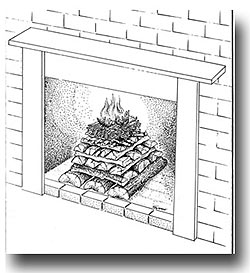 |
|
|||
| Sleepy Hollow Chimney Supply, Ltd. 85 Emjay Blvd. Brentwood, New York 11717 1-800-553-5322 FAX: 1-631-231-2364 | ||||
| Home Advantage History System FAQ Models PDF News Contact Us Links | ||||
| Super Flex Spider Damper Mantels Installations Distributors Installers Order Books Workshops | ||||
|
Bellfires Top Down Burn |
||||
|
|
||||
|
|
||||
|
Handy Items to Have: A Fireplace Screen A Kindling Ax (be careful) Stove Gloves An Ash Rake Think of your fuel load as three component parts: The Base Course (can be un-split if proper diameter) The Middle Course (split) The Top Courses (split finer) THIS TYPE OF FIRE IS NOT RECOMMENDED FOR THE FIRST EIGHT TO TEN FIRES. BELLFIRES MUST BE GRADUALLY BROKEN IN AND CURED WITH SMALL FIRES FOR THE FIRST EIGHT TO TEN FIRES. DO NOT OVERFIRE YOUR BCC!! A fireplace grate is not necessary with the BCC 28. A grate increases your critical burn rate allowing logs to burn faster than normal. Logs burn best in contact with hot firebrick in a bed of wood ashes. Helpful Hints & Precautions before you start:  Make sure your fireplace and flue have been inspected for fire worthiness and are cleaned if found dirty (full of flammable creosote), by a reputable Chimney Sweep. Make sure the damper is open. The damper is controlled from the keyed stainless cable and ring installed to either side of the firebox sidewall. Pull down and unhook to release the tension of the stainless steel cable. Pull down and re-hook the cable to close the damper. There are no other settings than completely open or completely closed. If your fireplace and flue are located on an outside wall or, when the damper is open, you feel a flow of frigid air rushing down into the room, pre-heat the flue with a sheet of lit newspaper. Hold the lit newspaper high into the damper area, wearing a pair of stove gloves for protection. This will reverse the cold air plug present in the flue, creating a strong updraft with no smoke into your room. As soon as the newspaper is burned up, light your newspaper on top of your fuel load. Approximately 3-4 hours later when you have a nice bed of hardwood coals, use a fireplace rake to push the coals against the rear wall of the firebox. Next, lay your new logs, minimum of four, on top of the hot coals, lay the bottom two horizontally. The top two, a little shorter in length, place front to back approximately 3 inches apart creating a throat. The greatest volume of smoke and particulate pollution from a wood fire occurs during a cold start up. Wood fires lit from the bottom, in a conventional manner, promote a dirty burn and waste a large amount of potential heat in the form of unburned gases. A clean and efficient method for kindling a fire is a top burn. This almost forgotten ancient European technique places the largest wood at the bottom in a crisscross crib fashion. As each tier is laid, the crisscrossing becomes smaller. Kindling and a small amount of paper are placed on top and lit. When the top burn fire is lit, the flames are always above the fuel load. The smoke and flammable gas from each tier of wood will always travel up through the flame and burn, thereby reducing particulate pollution and unburned fuel. A top kindling fire also produces large and less compacted flowing coals, providing excellent long-lasting radiant heat. A top burn fire laid with seasoned hardwood to a height of eighteen to twenty-four inches will burn approximately four hours without adding additional wood. The fire will be mesmerizing as each tier slowly ignites and burns its way down. TOP BURN RECIPE Always start with dry, well-seasoned, split firewood and kindling. (Ideally seasoned firewood will have a 20% moisture content. The wood will show radial cracks at the ends and sound like bowling pins when beaten together). Bottom layer: Three good sized pieces of split hardwood five to six inches thick, laid front to back. Second layer: Three slightly smaller pieces of split firewood three to five inches thick, laid side to side. Third layer: Four to five smaller pieces of split firewood two to three inches thick, laid front to back. Keep alternating and decreasing in size with split hardwood until they are about one inch thick. Now alternate two rows with split softwood (pine, spruce, etc.) until pencil thick. Place a small piece of newspaper on top and light. |
||||
